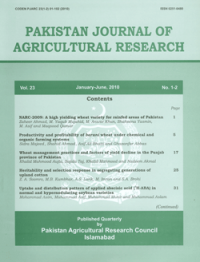HETEROSIS IN RELATION TO COMBINING ABILITY PER SE PERFORMANCE IN TEMPERATE RICE (ORYZA SATIVA L.)
Gulzar S. Sanghera and Wassem Hussain*
ABSTRACT
Thirty six (36) cross combinations developed by crossing 2 Cytoplamic male sterility (CMS) lines with 18 testers in line x tester mating design were evaluated to find out best heterotic combinations in terms of yield and yield components of rice (Oryza sativa L.). Analysis of variance revealed significant differences among genotypes, crosses, lines, testers and line x tester interactions for all the traits studied. The specific combining ability (SCA) effects along with per se performance revealed that some of the crosses have shown desirable SCA effects, having superior per se performance for most of the traits thus indicating the selection of these crosses. Based on standard check varieties (SR-1 and Jhelum) assessment of heterosis for effective restored cross combinations showed a significant heterosis for all the traits except number of filled grains per panicle. The results revealed that the degree of heterosis varied from trait to trait. All combinations that showed superiority over standard checks for grain yield per plant also showed significant heterosis for majority of other traits. The average proportion of restorers, partial restorers, partial maintainers and maintainers were 16:22:33:27, respectively. The best cross combination for grain yield was SKAU7A x K-08-61-2 and for early maturity SKAU11A x SR-2 over check variety SR-1 only. Cross combinations SKAU 7A x K-08-61- 2, SKAU 7A x SR-2, SKAU 11A x K-08-60-2, SKAU 11A x K-08-59-3 and SKAU 11A x SKAU-389 were the good specific combinations for grain yield per plant and other desirable traits and needs to be tested on large scale for their commercialization under temperate conditions.
To share on other social networks, click on any share button. What are these?







